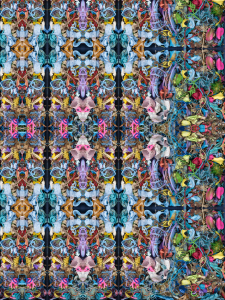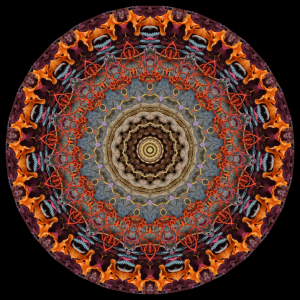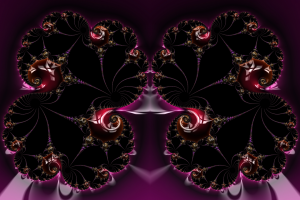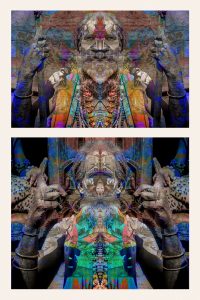Iterated Photographs |
This body of work is my bread-and-butter approach. The simplest iteration is the vertical iteration. As I have told many people over the years, using software you split a digital photograph into two parts, toss out the part you do not want, duplicate the remaining part. flip it vertically and line up the two matching edges. I first did this eleven years ago and the basic vertical symmetry still thrills me! In addition to vertical symmetry there are a number of other iterative approaches: horizontal, two-fold (vertical+horizontal,) radial, kaleidoscopic, affine (tessellation,) fractal, and combinations of these separate techniques.
Source photographs are almost always produced by setting up boxes full of materials. Although I do shoot photographs ‘out in the wild’ my photographic practice tends to stick to my backyard. The key to my approach to the photograph is to capture the set-up so as to amplify the conditions (for iteration) which make up the core of my art practice across the various bodies of work. I strive to take very crisp photographs from less than three feet away from the face of the set-up. This is close to, yet is not really a macro shot. The Depth of Field is usually about one inch from 12-30 inches away, using a 24mm lens. I really like evening light, texture, and shadows. Shadows are a crucial aspect of hiding patterns within the iterated image. Although I have to wrestle with the total environment at times, over the years I have continued to learn about how to photograph the all-important set-up. Basically, it is all about the set-up so I honor its centrality. |
Radially Iterated Photographs |
Radial iterations resolve circular images that are often mandala-like. These ‘circles’ can also be hypnotic, meditative, calming, and charming. Aside from their natural and archetypal qualities, a lot of details of a source set-up can be encapsulated by the radius or radii of the iteration. This means there is multiple vantage point: the whole and then its details. This is by definition true for most iterative art, yet this is especially true for me with the radial iteration of complex and densely detailed photographs. Other times radial iteration may be deployed to obtain a minimalist, op-art result. The math of possible radial iterations offers up impressive magnitudes of possibility, numbering in the billions for the largest square crop of my of my A7rII. This follows from the basic variety of radial iterations: regular and irregular periodic, sequential and scalar. Regular periodic radial iterations are the mainstay. I”ve been asked if circular artworks can be used to hypnotize a viewer. I always respond: “Go ahead and see for yourself!”
|
Generative Artwork |
Generative art requires some measure of autonomous manipulation of pixels. For me generative routines need to implicate either a random variable or need to be difficult to predict by virtue of their complexity. Unlike most generative artists, I am an auteur, not a coder. For years I used the programmer Leonardo Solaas’s Doodl browser-based procedural art tool. It allows an auteur (!) to feed into its routines original source images and manipulate the procedural pixel re-painting using a dozen or so parameters, all in real time. From over my shoulder this looks like shaping an animation instantly with the stream being repainted as one works the parameters. To realize a static image I would freeze the re-painting stream. With the deprecation of Flash at the end of 2020 this tool was lost to me.
There are still simple generative tools which are part of my toolbox. These are one trick app-based tools that come into their own in this body work when I combine them or set them to manipulations they weren’t intended to facilitate. I’ve been turning some recent images into cinema streams and then using those streams as sources for various video-oriented iterative experiments. |
Iterated Fractals |
Frax is the most luxurious mobile/tablet app for creating original fractals. It is a deep app (for IOS) yet it is easy to use too. It’s intuitive modes allow for spectacular results. With it I can make both static and animated fractals. This body of work by design tends to focus on using wondrous fractals to anchor more minimal iterative approaches. Fractals which implicate various kinds of conditions (that I favor,) may be employed as sources for simple vertical iterations or short-form animations.
My fractal work goes in the opposite direction from all the jaw-dropping fractal zooms and 3d fractal work. Fractals provide ripe sources for light boxes and large scale installations. Some fractals are oriented toward more through-design iterative images and these often end up as sources for print-on-demand products—think leggings and throws and jigsaw puzzles! |
Iterated Stochastic Artworks |
‘Stochastic’ is a term of art for this body of work. It means that there is an element of selection given an array of image layers that is not under my control. What is under my control is the ability to trigger selections. What I do is create an array of images to be the source of selection and then using the selection and blending app FotoDa (IOS) I trigger selection/blending combinations until it creates something usable. Next i try to turn the usable image into something worthwhile from my perspective.
Although the autonomous element is clear enough this approach does not invoke AI. The selection routines do not learn. They are probably cycling yet my impression is each trigger seems unique. This body-of-work supports the common mistaken impression that a public image reflects a great deal of determined software manipulation. This is wrong: the manipulation that counts is literally serendipitous. I spend the winter in the generative and stochastic realm, aiming for something to pop on the screen. Reverie! |
Didactic Fours |
My background includes a life-forming investigation of experiential learning and adult development. This is why my entire creative mission aims at the conclusion of the visual experiment ending in the consciousness of the present viewer. This describes a virtuous circle; thank you John Dewey and William James!
The Didactic Fours artworks bring together related radial iteration of photographs and root each one to a single descriptive or conceptual term, each related to one another within the ‘frame’ of the work. These terms, aggregated in groups of four, are all rooted in various means and methods of learning and development. I’m the only one doing this in the world, so, there’s that! |
Light Box & LED Display |
The picture here shows me in 2018 standing in front of an 11×17 foot high definition LED video wall at Colortone Staging here in Cleveland. On the wall is an excerpt of my artwork, Long John Brown and Little Mary Bell. This was a proof-of-concept moment for me. Of course now in 2022, video walls and large format projection is at the technical center of the immersive art revolution.
In my catalog are a handful of designs shaped to be exhibited at immersive scales, or at smaller scales to be exhibited as cloth or duratrans light boxes. This approach is at the top of my list of next level initiatives. Light boxes will be the first point of focus. My go-to printer Vista Color Imaging has a 12 foot wide dye sublimation printer and I’ve got a store of possible images for it. |
Digital Cinema & Sound Design |
When I was deconstructing my digital audio studio in 2018 I thought to myself that I might get back to composing and music-making were sound become an aspect of a future art practice. Here in early 2022 it seems maybe the time has come. I have been making 30 second to 2 minute iPhone cinema videos of fractals and other sources and as these pile up—some are quite compelling—I am hearing the call to outfit the short productions with sound, which for me means ambient music, drones, and electronic music. I will probably start by exclusively using my iPhone 12 as a sound design studio. Stay tuned! |
| Portfolio | Artist’s Statement |






